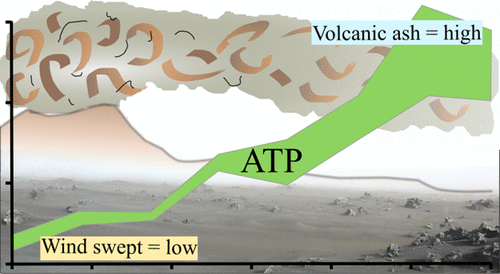当前位置:
X-MOL 学术
›
ACS Earth Space Chem.
›
论文详情
Our official English website, www.x-mol.net, welcomes your
feedback! (Note: you will need to create a separate account there.)
Preferably Plinian and Pumaceous: Implications of Microbial Activity in Modern Volcanic Deposits at Askja Volcano, Iceland, and Relevancy for Mars Exploration
ACS Earth and Space Chemistry ( IF 2.9 ) Pub Date : 2020-07-29 , DOI: 10.1021/acsearthspacechem.0c00015 Erika Rader 1 , Anna Simpson 2 , Elena Amador 3 , Julia M. Fraser 2 , Samuel Holtzen 2 , Ashley Hanna 2 , Morgan L. Cable 3 , Thomas Cullen 4 , Zach Duca 2 , Diana Gentry 5 , Gayathri Murukesan 6 , Vincent Rennie 7 , Adam H. Stevens 8 , Scot Sutton 2 , George Tan 2 , David Cullen 4 , Wolf Geppert 9 , Amanda Stockton 2
ACS Earth and Space Chemistry ( IF 2.9 ) Pub Date : 2020-07-29 , DOI: 10.1021/acsearthspacechem.0c00015 Erika Rader 1 , Anna Simpson 2 , Elena Amador 3 , Julia M. Fraser 2 , Samuel Holtzen 2 , Ashley Hanna 2 , Morgan L. Cable 3 , Thomas Cullen 4 , Zach Duca 2 , Diana Gentry 5 , Gayathri Murukesan 6 , Vincent Rennie 7 , Adam H. Stevens 8 , Scot Sutton 2 , George Tan 2 , David Cullen 4 , Wolf Geppert 9 , Amanda Stockton 2
Affiliation

|
To search more efficiently for a record of past life on Mars, it is critical to know where to look and thus maximize the likelihood of success. Large-scale site selection for the Mars 2020 mission has been completed, but small (meter to 10 cm)-scale relationships of microenvironments will not be known until the rover reaches the surface. Over a 2 m transect at a modern volcanic deposit on the flank of Askja volcano in the barren highlands of Iceland, we compared two biological indicators (ATP activity and 16SrRNA amplicon sequence composition) to physical characteristics including bulk chemical composition, spectral signatures of mineralogy, and grain size. Using analytical instrumentation analogous to those available on Mars rovers, we were able to characterize the geological setting of the deposits and link physical parameters to microbial abundance and diversity. In general, methanogenesis, methanotrophy/methylotrophy, and nitrate reduction were the functional traits most associated with microbial community shift along the transect. Core microbiome members tended to be associated with nitrate reduction, and relative abundance of core microbes was strongly related to free water in the deposit. Community compositional shift of the rare microbiome was related to microenvironmental changes such as change in grain size, geochemistry, and age of deposit. These correlations lead us to suggest a sampling strategy that accounts for Martian geology, looking for undisturbed (not remobilized) explosive volcanic ash below pumice that could maximize diversity and abundance of different bioindicators. Our study also illustrates the importance of studying the variability across microenvironments in low biomass settings on earth.
中文翻译:

最好为Plinian和Pumaceous:冰岛Askja火山现代火山沉积中微生物活动的意义以及与火星探测的相关性
为了更有效地搜索火星上的前世记录,至关重要的是知道在哪里看,从而最大程度地获得成功。火星2020任务的大规模选址已经完成,但是直到流动站到达水面之前,才知道微环境的小(米至10厘米)比例关系。在冰岛贫瘠的高地Askja火山侧翼的现代火山沉积物上一个2 m的横断面上,我们比较了两个生物学指标(ATP活性和16SrRNA扩增子序列组成)与物理特征,包括整体化学组成,矿物学的光谱特征,和晶粒尺寸。使用类似于火星探测器上可用的分析仪器,我们能够表征矿床的地质环境,并将物理参数与微生物的丰度和多样性联系起来。通常,产甲烷,甲烷氧化/甲基营养和硝酸盐还原是与微生物群落沿样带转移最相关的功能性状。核心微生物组成员往往与硝酸盐还原有关,核心微生物的相对丰度与矿床中的游离水密切相关。稀有微生物组的群落组成变化与微环境的变化有关,例如粒度,地球化学和沉积年龄的变化。这些相关性促使我们提出一种解释火星地质的采样策略,在浮石下面寻找不受干扰(未迁移)的火山灰,以使不同生物指示剂的多样性和丰度最大化。我们的研究还表明,研究地球上生物量较低的环境中微环境的变异性的重要性。
更新日期:2020-09-18
中文翻译:

最好为Plinian和Pumaceous:冰岛Askja火山现代火山沉积中微生物活动的意义以及与火星探测的相关性
为了更有效地搜索火星上的前世记录,至关重要的是知道在哪里看,从而最大程度地获得成功。火星2020任务的大规模选址已经完成,但是直到流动站到达水面之前,才知道微环境的小(米至10厘米)比例关系。在冰岛贫瘠的高地Askja火山侧翼的现代火山沉积物上一个2 m的横断面上,我们比较了两个生物学指标(ATP活性和16SrRNA扩增子序列组成)与物理特征,包括整体化学组成,矿物学的光谱特征,和晶粒尺寸。使用类似于火星探测器上可用的分析仪器,我们能够表征矿床的地质环境,并将物理参数与微生物的丰度和多样性联系起来。通常,产甲烷,甲烷氧化/甲基营养和硝酸盐还原是与微生物群落沿样带转移最相关的功能性状。核心微生物组成员往往与硝酸盐还原有关,核心微生物的相对丰度与矿床中的游离水密切相关。稀有微生物组的群落组成变化与微环境的变化有关,例如粒度,地球化学和沉积年龄的变化。这些相关性促使我们提出一种解释火星地质的采样策略,在浮石下面寻找不受干扰(未迁移)的火山灰,以使不同生物指示剂的多样性和丰度最大化。我们的研究还表明,研究地球上生物量较低的环境中微环境的变异性的重要性。










































 京公网安备 11010802027423号
京公网安备 11010802027423号